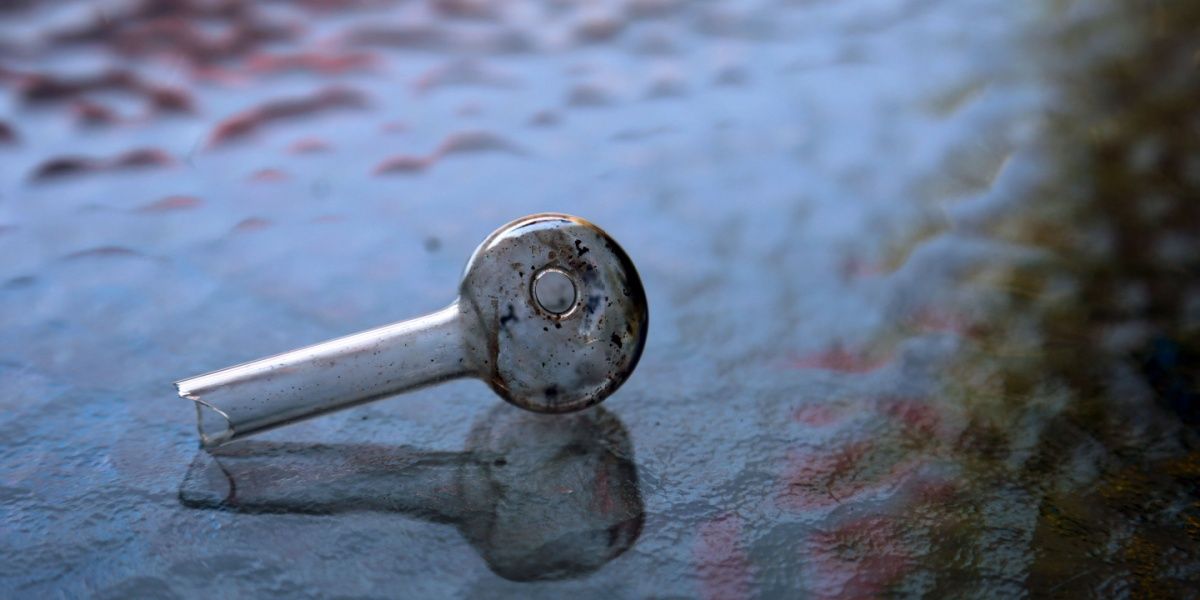Drug paraphernalia refers to objects and items that are used in the taking, selling, or manufacturing of illicit drugs. Knowing what specific drug paraphernalia looks like can help with the early identification of a substance use disorder.
- Items such as bongs, syringes, smoking papers, or a variety of pipes are commonly used in the administration of drugs. However, common household objects can be repurposed for drug use, such as spoons, cotton balls, or lighters, becoming drug paraphernalia themselves.
- According to the 21 U.S. Code 863, it is illegal to sell, transport, import, and export drug paraphernalia anywhere in the USA. Anyone found to be doing so can be jailed for up to 3 years and fined.
- It can be disturbing to discover drug paraphernalia belonging to a family member or friend. If you suspect someone you care about is using drugs, it is important to confront them and encourage them to get the help they need.
.jpg?v=1722503350)
Drug paraphernalia definition
Drug paraphernalia refers to any items used for producing, testing, storing, administering, or consuming controlled substances.[1]
Items such as bongs, syringes, smoking papers, or a variety of pipes are commonly used in the administration of drugs. However, common household objects can be repurposed for drug use, such as spoons, cotton balls, or lighters, becoming drug paraphernalia themselves.
Paraphernalia and signs of drug use
Whilst drug paraphernalia is a clear sign of drug use, it does not determine the frequency of drug taking.
As such, an item of drug paraphernalia alone may not be a sign of addiction. Signs of addiction can be broken down into behavioral, physical, and emotional sections. One or more of these may indicate drug addiction:
Behavioral symptoms
- Lack of interest in everyday activities.
- Isolating themselves from friends and family.
- Lack of personal hygiene.
- Falling standards in work or school.
- Financial trouble.
- Legal trouble.
- Relationship breakdown.
- Violent behavior.
- Stealing things.
Physical symptoms
- Bloodshot eyes.
- Pinpoint pupils.
- Regular fatigue.
- Constant itching.
- Slurring speech.
- Regular nosebleeds or dripping nostrils (cocaine use).
- Poor coordination.
- Insomnia.
Emotional symptoms
- Persistent irritability.
- Heavy mood swings.
- Euphoria and high energy.
- Hallucinations.
- Denial.
- Paranoia.
- Suicidal thoughts or actions.
The symptoms will vary depending on the drug being taken. Exhibiting one or more of these symptoms does not necessarily mean drug use is to blame.
If you believe your friend, child, or another family member may be addicted to drugs, attempt to uncover another explanation first before confronting them and encouraging them to get the professional help they need. Read here for more warning signs of addiction.
Identifying drug paraphernalia
Drugs are associated with an array of paraphernalia. Below is a list of different controlled substances and the paraphernalia associated with them.
Cannabis paraphernalia
Cannabis (marijuana) is one of the most abused drugs in the USA. Irrespective of its state-by-state legal status and the ability to buy it from a legitimate supplier, marijuana addiction still regularly occurs. Typically smoked, vaporized, or consumed orally, the following items constitute cannabis paraphernalia:
- Rolling papers.
- Pipes (glass, wood, or ceramic pipes are commonly sold in tobacco shops).
- Roach clips.
- Blunt wraps.
- Bongs.
- Vaporizers.
- Torn cigarettes.
- E-cigarettes used to vaporize cannabis
- Broken lighters.
- Roach paper.
Cocaine paraphernalia
Cocaine is a white, highly addictive powdered substance. It is typically snorted but can also be injected, smoked, or otherwise consumed orally. Crack cocaine is a type of cocaine that is usually vaporized and smoked in a pipe. Crack cocaine appears more addictive than cocaine, as smoking the substance achieves maximal effect far more rapidly than snorting and has a shorter half-life.[2] The paraphernalia for cocaine varies depending on how it is taken:
- Pipes.
- Cards tinged with white powder.
- Bank notes tinged with white powder (for intranasal use).
- Spoons.
- Plastic straws (for intranasal use).
- tubes such as biro casings.
- Razor blades.
- Lighters.
- Little plastic bags with remnants of white powder.
- Testing equipment, such as fentanyl strips.
Heroin paraphernalia
Heroin is a Schedule I illegal drug, which is considered highly addictive and dangerous. Typically injected, but also smoked, snorted, and inhaled, there is a range of paraphernalia associated with heroin.
Injecting requires the most paraphernalia and has a relatively intricate preparation process when compared with other methods of consumption.
- Lighter/Candle – heat used to melt heroin into a liquid
- Small spoon – typically used to cook powdered, tarred, or solid heroin into a liquid for intravenous injection.
- Cotton balls – to filter the heroin through and separate the liquid from any impurities or solid bits that didn’t melt.
- Tie off – anything that resembles a string or shoelace that is tied around a limb to make veins more prominent.
- Needle/Syringe – used to inject the heroin into the body; often in the arm, hands, or feet (between the toes).
Smoking heroin is the next most common way of consuming heroin, with paraphernalia including:
- Aluminum foil – used to wrap and heat heroin within
- Lighter/Candle – placed under the foil to melt the heroin and release smoke.
- Straw – used to inhale the smoke released by the heroin after heating
- Rolling paper/pipe – heroin can also be rolled into a cigarette or smoked in a pipe
Methamphetamine paraphernalia
Also known as meth, crystal meth, or ice, methamphetamine is a powerful CNS stimulant drug. Commonly sold in bags, meth resembles little glass fragments, hence the aforementioned nicknames. Methamphetamines are usually smoked or injected. They are extremely addictive and dangerous to your health. Paraphernalia includes:
- Pipes (often homemade from household items such as water pipes).
- Needles/syringes.
- Light bulbs.
- Tin foil.
- Spoons (for cooking meth).
- Razor blades (used for cutting meth into lines).
- Shoe laces or string (for making veins bulge for injection).
- Cut straws (for intranasal use).
- Cut pens (for intranasal use).
- Testing equipment, such as fentanyl strips.
MDMA/Molly/Ecstasy paraphernalia
MDMA, also commonly known as Molly or ecstasy, acts as both a stimulant and psychoactive drug, giving users a powerful high, distorting their sense of time, and enhancing their enjoyment of tactile behavior. They are typically taken in pill or powdered form and commonly used recreationally at nightclubs or raves. Here is a list of paraphernalia associated with MDMA:
- Vapor Rub – mixing Molly with vapor rub for inhalation; said to heighten the effect of the drug.[3]
- Surgical face masks – rubbing the Vapor Rub on the inside of the face mask to inhale the fumes.[3]
- Lollipops/candy necklaces – to minimize teeth grinding/jaw clenching whilst on MDMA.
- Small bags with white powder – packages containing MDMA.
Inhalant paraphernalia
People may inhale household items, such as glues or aerosol cans, or industrial chemicals to get high. As they are easy and, in many cases, legal to obtain, it is difficult to prevent people from using inhalants. However, sniffing glue, paint, felt tips, or other chemical inhalants can be extremely dangerous. It can lead to suffocation, choking, cardiac arrest, oxygen deprivation, adverse reactions to chemicals, and can even cause an explosion if handled crudely. Here are some paraphernalia associated with inhalants:
- Glue tubes.
- Balloons.
- Aerosol cans.
- Rags, cloths, bandanas, or old clothes soaked in chemicals.
- Cotton balls.
- Empty nitrous canisters (whippets).
- Galaxy gas canisters.
Any medium through which someone can store a chemical substance and then ‘huff’ or inhale the fumes can be considered inhalant paraphernalia.
Drug paraphernalia and the law
According to the 21 U.S. Code 863, it is illegal to sell, transport, import, and export drug paraphernalia anywhere in the USA.[4] Anyone found to be doing so can be jailed for up to 3 years and fined.
Possession of drug paraphernalia is typically illegal under state law; however, it must be established that the item in question is definitely being used for drug use before prosecution.
Many head shops across the nation have disclaimer signs near potential drug paraphernalia, such as pipes, bongs, cannabis grinders, and vaporizers, stating that these items are not to be used with drugs.
What to do if you find drug paraphernalia
It can be disturbing to discover drug paraphernalia belonging to a family member or friend. If you suspect someone you care about is using drugs, it is important to confront them and encourage them to get the help they need.
Intervention
Whether it is for a spouse, child, or close friend, the first step is initiating an open and frank conversation with them about their drug use. Establish if and when they started using drugs, what other drugs they take, how often they take them, and what made them start.
It is important to let them know you want to understand them and are coming from a place of kindness and consideration. Then, you can impress upon them how dangerous drug use can be and that using them is unacceptable.
Follow these 5 steps if you have reason to think your child is using drugs:[5]
- Get on the same page – take a collaborative approach to their drug taking, rooted in the love you bear for one another.
- Gather any evidence – reveal the paraphernalia you’ve uncovered and discuss any physical, emotional, or behavioral symptoms you’ve noticed
- Remain calm in the face of anger/denial – brace yourself for your child to lash out. They may feel vulnerable and judged or flat-out refute seemingly incontrovertible evidence. Remain calm and impress upon them that you love them and want what’s best.
- Define consequences and rules going forward – have a pre-ordained set of consequences and rules going into the conversation. Discuss these with the other primary caregiver, and set limits to encourage behavioral change.
The same framework can be applied to a spouse, friend, or family member. Ultimately, the goal is to show the person you care about them, want what is best for them, and establish a plan going forward to stop drug use. Read here for more guidance on interventions.
Speaking to a professional
If you are worried about your partner, child, or friend’s potential drug use, you are not overreacting and ought to take immediate action. Contacting your own doctor, a substance use professional or family therapist, or a group counselor is all viable ways of getting the professional help you need.
Describe your family member’s behavioral changes, any signs you’ve discovered indicating their drug use e.g. ,drug paraphernalia, and how they themselves responded to confrontations over their drug use.



-guide-detail.jpg?v=1722502132)
